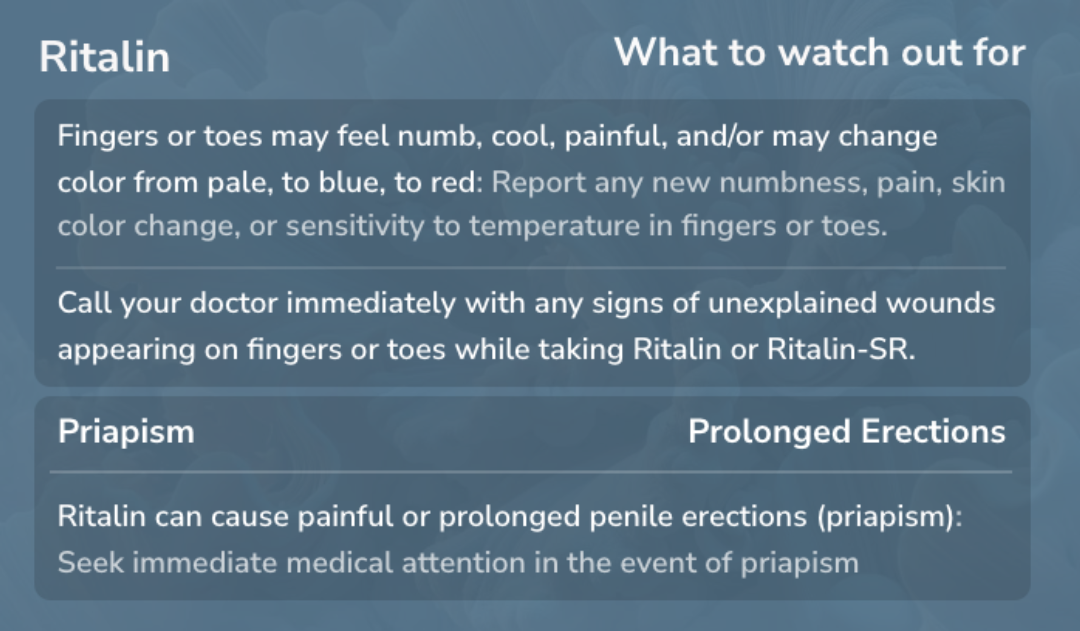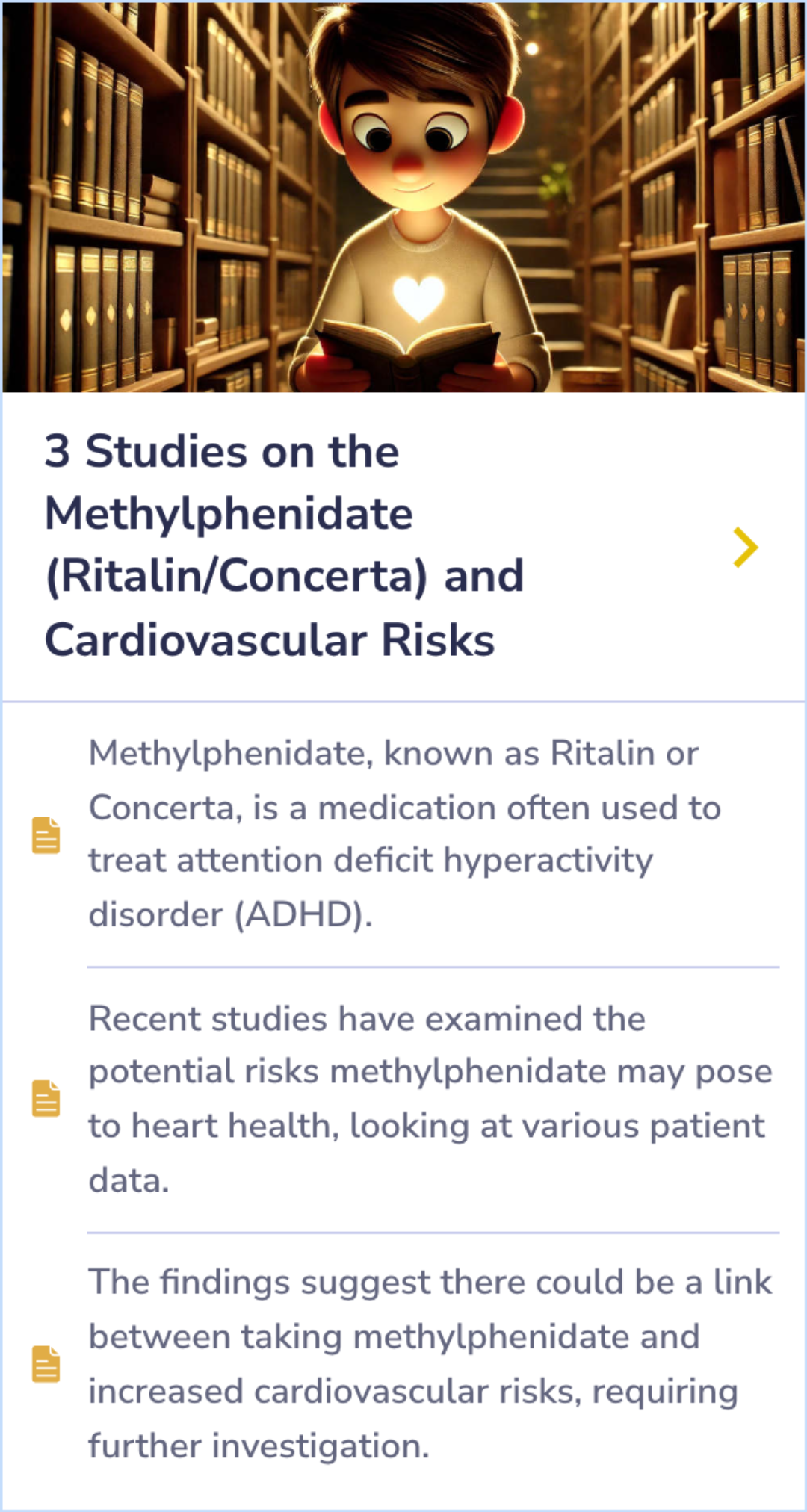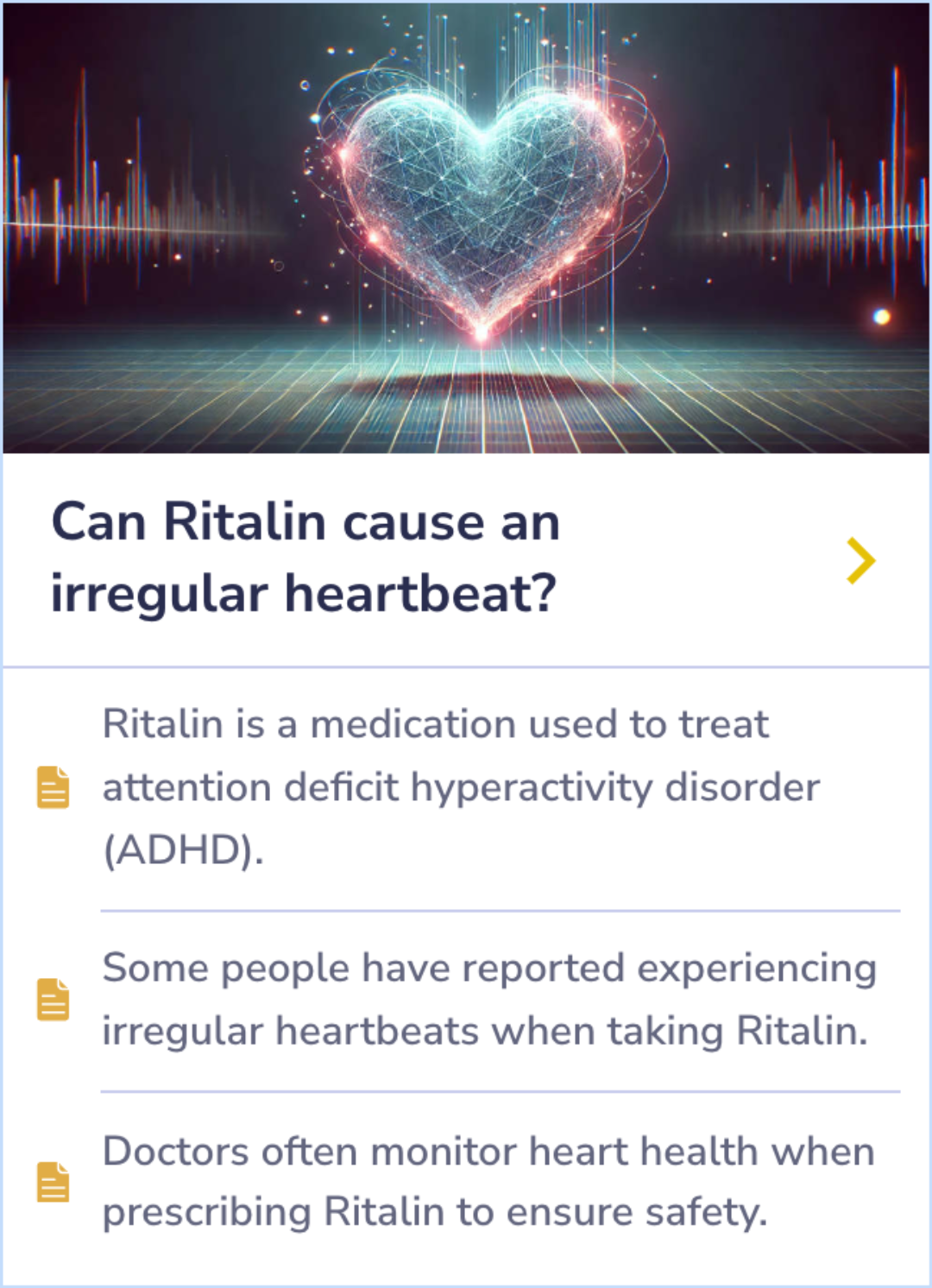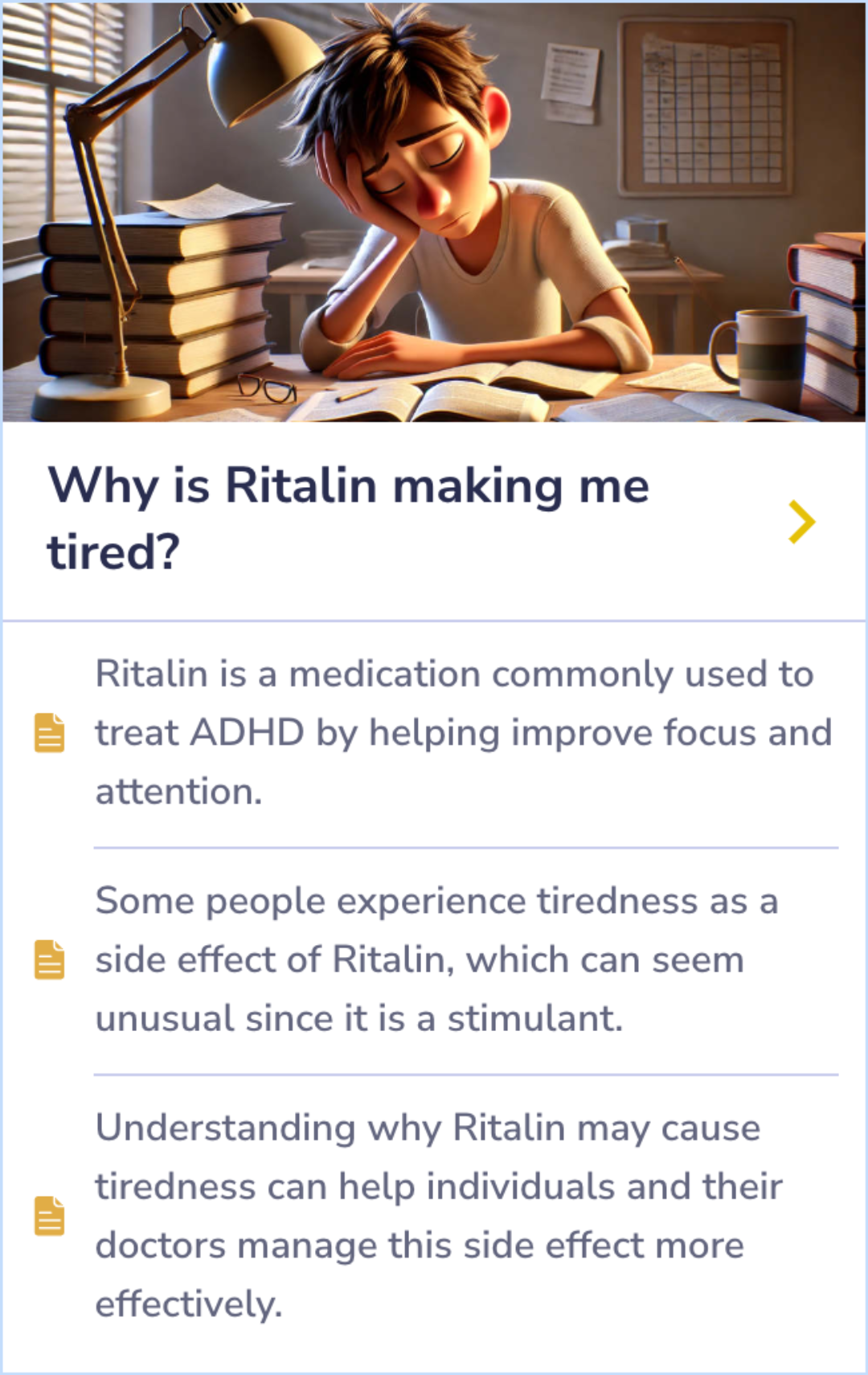Ritalin
Evidence Based Answers
Ritalin - Things to watch out for
Ritalin can impact heart rate and blood pressure, cause numbness in fingers or toes resembling Raynaud’s phenomenon, and in rare cases, lead to painful prolonged erections needing urgent attention.
Published: November 9, 2024

Beware Ritalin's heart, skin, and rare priapism side effects.
Ritalin and Cardiovascular Effects
Methylphenidate, the active ingredient in Ritalin, can affect the cardiovascular system, leading to changes in blood pressure and heart rate. Some individuals may experience symptoms such as palpitations or nervousness.
These effects depend on factors like individual sensitivity and dosage. It is recommended to be aware of any new or worsening cardiovascular symptoms.
These effects depend on factors like individual sensitivity and dosage. It is recommended to be aware of any new or worsening cardiovascular symptoms.
“
Source Quotes:
Adverse reactions seen under normal therapeutic conditions, but which may be attributed to mild overdosage, include nervousness, insomnia, hypersensitivity, anorexia, nausea, dizziness, palpitations, headaches, dyskinesia, drowsiness, changes in blood pressure, tachycardia and weight loss following prolonged therapy.
The effects of methylphenidate are a result of dopamine signal amplification and dependent in part on dopamine cell activity, which itself is responsive to environmental stimulation.
Peripheral Vasculopathy and Numbness
Ritalin use may lead to peripheral vasculopathy, which impacts the blood vessels in the fingers and toes. This can result in numbness, color changes, or discomfort, especially in cold temperatures.
Symptoms may resemble Raynaud’s phenomenon, characterized by color changes and pain in the affected areas. New or worsening symptoms should be discussed with a healthcare provider.
Symptoms may resemble Raynaud’s phenomenon, characterized by color changes and pain in the affected areas. New or worsening symptoms should be discussed with a healthcare provider.
“
Source Quotes:
Instruct patients beginning treatment with Ritalin or Ritalin-SR about the risk of peripheral vasculopathy, including Raynaud’s Phenomenon, and in associated signs and symptoms: fingers or toes may feel numb, cool, painful, and/or may change color from pale, to blue, to red.
Dermatologically, patients can complain of excessive sweating and ulceration of their digits.
Priapism: A Rare Side Effect
Though rare, Ritalin may cause priapism, a condition involving prolonged and painful erections that require immediate medical attention.
Both adults and children can be affected, and prompt evaluation is crucial to prevent serious complications.
Both adults and children can be affected, and prompt evaluation is crucial to prevent serious complications.
“
Source Quotes:
Prolonged and painful erections, sometimes requiring surgical intervention, have been reported with methylphenidate products in both pediatric and adult patients.
While it rarely occurs, priapism is a medical emergency that requires immediate attention.
Unexplained Wounds and Skin Reactions
Ritalin use has been linked to unexplained wounds on the fingers or toes, which may indicate underlying vascular issues. Patients noticing such symptoms should contact a healthcare provider.
Other skin reactions, such as ulceration or excessive sweating, may occur and require prompt management.
Other skin reactions, such as ulceration or excessive sweating, may occur and require prompt management.
“
Source Quotes:
Instruct patients to call their physician immediately with any signs of unexplained wounds appearing on fingers or toes while taking Ritalin or Ritalin-SR.
On physical exam, look for peripheral vasculitis (digital ulceration).
Key Takeaways
Conclusions
Ritalin, containing methylphenidate, has notable effects on the cardiovascular system, potentially altering blood pressure and heart rate, with symptoms like palpitations or nervousness. Dosage and personal sensitivity play significant roles in these reactions.
Peripheral vasculopathy is another concern, leading to finger and toe numbness, particularly in cold conditions. Symptoms resembling Raynaud's phenomenon and unexplained wounds warrant attention. Rarely, priapism, a prolonged painful erection, can occur, needing swift medical care.
Peripheral vasculopathy is another concern, leading to finger and toe numbness, particularly in cold conditions. Symptoms resembling Raynaud's phenomenon and unexplained wounds warrant attention. Rarely, priapism, a prolonged painful erection, can occur, needing swift medical care.

Evidence Summary
Exploring Heart Health Risks with Methylphenidate
Recent studies are exploring the potential cardiovascular risks associated with methylphenidate, a medication commonly used to treat ADHD. Data from these studies indicate there might be a connection between methylphenidate use and increased risks to heart health.
Methylphenidate, known by brand names like Ritalin and Concerta, is undergoing closer scrutiny as researchers analyze patient data to uncover whether there’s a significant impact on heart rate, blood pressure, and other cardiovascular markers.
Ongoing investigations aim to clarify how methylphenidate affects the heart, especially considering its influence on dopamine and related neurotransmitters.
Methylphenidate, known by brand names like Ritalin and Concerta, is undergoing closer scrutiny as researchers analyze patient data to uncover whether there’s a significant impact on heart rate, blood pressure, and other cardiovascular markers.
Ongoing investigations aim to clarify how methylphenidate affects the heart, especially considering its influence on dopamine and related neurotransmitters.
Evidence Summary
Ritalin and Heart Health: Monitoring Risks
Ritalin, used to treat ADHD, has been linked to reports of irregular heartbeats in some individuals. This highlights the importance of monitoring by healthcare professionals to ensure patient safety and respond to any potential issues quickly.
Some patients taking Ritalin have reported experiencing irregular heart rhythms, leading doctors to frequently monitor heart health to minimize risks and address concerns early.
Ensuring patient safety during treatment involves careful observation by medical providers to detect and manage any cardiac effects.
Some patients taking Ritalin have reported experiencing irregular heart rhythms, leading doctors to frequently monitor heart health to minimize risks and address concerns early.
Ensuring patient safety during treatment involves careful observation by medical providers to detect and manage any cardiac effects.
Evidence Summary
Unexpected Tiredness from Ritalin
Ritalin is prescribed to improve focus and attention in individuals with ADHD. Despite being a stimulant, it can lead to unexpected tiredness in some users, a side effect that may seem contradictory to its intended purpose.
While enhancing focus, certain individuals experience fatigue, highlighting the diverse responses to the medication. Exploring this helps patients and healthcare providers navigate daily challenges more effectively.
While enhancing focus, certain individuals experience fatigue, highlighting the diverse responses to the medication. Exploring this helps patients and healthcare providers navigate daily challenges more effectively.


